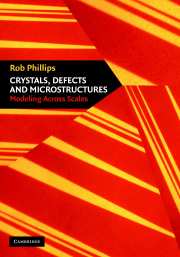Book contents
- Frontmatter
- Contents
- Preface
- Acknowledgements
- Notes on Units, Scales and Conventions
- Part One Thinking About the Material World
- Part two Energetics of Crystalline Solids
- Part three Geometric Structures in Solids: Defects and Microstructures
- Part four Facing the Multiscale Challenge of Real Material Behavior
- 11 Points, Lines and Walls: Defect Interactions and Material Response
- 12 Bridging Scales: Effective Theory Construction
- 13 Universality and Specificity in Materials
- References
- Index
13 - Universality and Specificity in Materials
Published online by Cambridge University Press: 29 October 2009
- Frontmatter
- Contents
- Preface
- Acknowledgements
- Notes on Units, Scales and Conventions
- Part One Thinking About the Material World
- Part two Energetics of Crystalline Solids
- Part three Geometric Structures in Solids: Defects and Microstructures
- Part four Facing the Multiscale Challenge of Real Material Behavior
- 11 Points, Lines and Walls: Defect Interactions and Material Response
- 12 Bridging Scales: Effective Theory Construction
- 13 Universality and Specificity in Materials
- References
- Index
Summary
The purpose of this, our final chapter, is first to revisit some of the key phenomena faced in the task of modeling materials. In particular, we reflect on the complementary objectives of explicating both universality and specificity in materials. Our use of these words is very deliberate and is meant to conjure up two widely different perspectives. Universality refers to those features of material response which are indifferent to the particulars of a given material system. For example, huge classes of materials obey the simple constitutive model of Hooke in the small deformation regime. Similarly, both the low- and high-temperature specific heats of many solid materials obey the same basic laws. And, we have seen that the yield strength scales in a definite way with the grain size, again, in a way that is largely indifferent to material particulars. As a last example, the simple continuum model for diffusion we set forth is relevant for a great variety of materials. By way of contrast, there is a set of questions for which the answer depends entirely upon the details of the material in question. Indeed, our emphasis on material parameters and the numbers that can be found in databooks forms a complementary set of questions about materials. Our hope is to contrast these two conflicting perspectives and to show the way each is important to the overall endeavor of understanding material response.
Once we have finished the business of universality and specificity, the final discussion of the chapter, and indeed of the book as a whole, will serve as a personal reflection on what appear to me to be some of the more intriguing and fertile realms for reflection in…
- Type
- Chapter
- Information
- Crystals, Defects and MicrostructuresModeling Across Scales, pp. 742 - 756Publisher: Cambridge University PressPrint publication year: 2001



